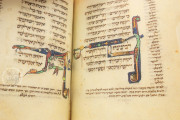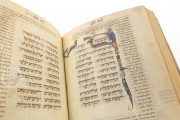The Parma Psalter is one of the most significant and earliest Hebrew psalters to ever reach modern times, and it is a treasure of the Palatina Library in Parma, Italy. Written and illuminated around 1280 in the north-western region of the Italian peninsula, the codex exhibits a rich decorative apparatus and features, in all of its 452 pages, a biblical text written in a large Sephardi type of square script accompanied by vocalization and accents in the same color ink.
A Lavish Work for a Wealthy Patron
The manuscript contains several psalms, each numbered and richly illuminated and illustrated; indeed, accompanying the text are elegantly depicted musical instruments or detailed images representing the scenes narrated in the text.
Due to the lavishness of the Parma Psalter, the commissioner must have been a very wealthy patron, possibly well-educated due to the presence of the commentary by Ibn Ezra, whose early copies are very rare to find, especially on psalms. The codex features contents related to several ceremonies such as marriages, funerals, engagements, and circumcisions.
Rare Examples of Contemporary Musical Instruments
The manuscript contains 150 psalters which, it has been suggested, could correspond to the readings part of the Pentateuch, a three-year cycle. The Parma Psalter plays a significant role for musicologists and art historians of the middle ages, for it bears illustrations of contemporary musical instruments, which are extremely rare to find.
The decorative apparatus exhibits rich ornaments featuring the use of harmonious colors and gold, with an elegant balance between text and images. The Parma Psalter, in addition to being one of the most important treasures of Hebrew illumination, is also the greatest treasure of one of the richest Hebrew manuscript collections in the Palatina Library in Parma, Italy.
Abraham Ibn Ezra: A Multidisciplinary Author
The author of the text contained in the Parma psalter – born in 1089 in Tudela, Spain – was a multidisciplinary scholar with interests varying from mathematics to grammar to philosophy, combining rationalism with a strong belief in astrology. Despite his poor health for most of his life, he managed to travel a lot facing his ill-fated life with humor and wit.
The figure of Abraham Ibn Ezra is one of the most renowned and respected in terms of his literary production, which features a complex use of language and a deep understanding of human nature. His commentaries are still object of attention and studies by students for their encyclopaedic aspects and their critical perspective.
Provenance of the Parma Psalter
The manuscript was thought to be completed in Rhodes in the year 1156; however, this date corresponds to that in which the Jewish author wrote the original commentary and not the manuscript at hand. The commentary seems to have been written in Rouen in Northern France, while the manuscript of the Parma Psalter was written in Emilia-Romagna, Italy.
One Manuscript, Many Different Hands
Although the manuscript appears as a hand-produced book whose style is consistent from beginning to end, a more thorough analysis points to a variety of layers added over time.
Special prayers were added at the end of the manuscript (fols. 215b-225a), including services for the ceremonies of engagement, wedding, circumcision, and burial. The text of this liturgical appendix was written at the end of the Middle Ages in a Sephardi type of square script, and the instructions in a semi-cursive version of the script. At the end of this appendix, on the blank folios left by this copyist, another hand, employing an Italian-Ashkenazi script, added an incomplete index to the psalms (fols. 225b-226b).
Decades later, one of the owners or users of the Parma Psalter added, in a late-Sephardi semi-cursive script, indications on the division of the psalms into the seven parts corresponding to the seven days of the week (fols. 57b or 100a).
We have 1 facsimile edition of the manuscript "Parma Psalter": Parma Psalter facsimile edition, published by Facsimile Editions Ltd., 1996
Request Info / Price



















